Jason Rivers blog by Joe Jackson
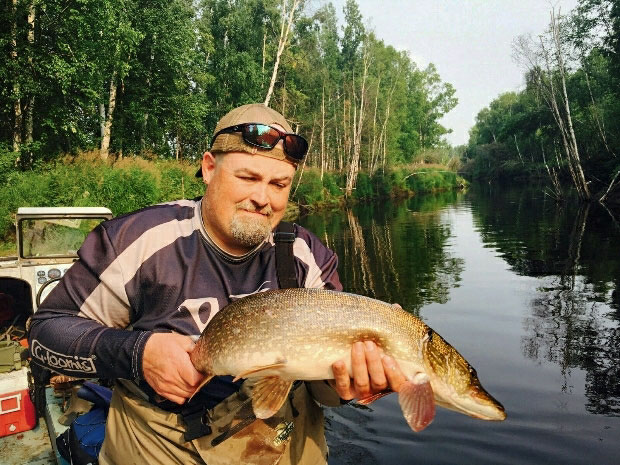
Rivers in his Alaskan element: pike fishing in the Interior.
The fly is every bit of what I’d call “unconventional,” and the best way I can describe it is a hybrid of something extraterrestrial and a long-lost member of the arthropod family. It might be a pattern you’d use for bonefish in the Bahamas—a veritable crustacean imitation—if it wasn’t nine inches long. Perhaps the strangest thing about this fly, though, aside from the facts that it looks like it could latch onto your face à la Ridley Scott’s Alien and is affectionately called the STD, is that it is meant to be fished up to 200 feet deep for one of Alaska’s favorite fish: Pacific halibut.
I love wacky flies. It’s fulfilling to learn the history of traditionally esteemed patterns like the Intruder or the Woolly Bugger, but in the same way that it’s appealing to play in the mud, it’s just plain fun to seek out absurd abominations from behind the vise. Naturally, I knew I had to talk to Jason Rivers.
As a brainchild of Rivers’, the STD is not alone. Stacked in his fly boxes you’ll also find the Barbie Doll, the Sushi Buffet, the Octospawn, the Trashcan Miley, and, my personal favorite, the Christmas Turd. Sure, some of Rivers’ creations are the epitome of “wacky,” but take a look at any one of them and you’ll know it was tied by someone with an unbridled talent and, perhaps even more rare, the ability to chuck convention to the wind.
A product of the Colorado outdoors, Rivers grew up with plenty of hunting opportunities, although strangely he didn’t fish much. It wasn’t until much later in life—by which point he’d gotten married, started a family, and moved to Washington—that he took up an interest in the hook and the line. And when he did, he was head over heels.
His interest in flyfishing is probably better categorized as a flash-minted obsession. He can recall in vivid detail how it began: the unfettered, emerald waters of the Kalama River; a steelhead guide working a pool with a fly rod, long and limber; a platinum steelhead, hoisted briefly so that Rivers, watching from the streamside brush, could see that it was as long as his leg. It was a moment in which he knew he had to get into flyfishing.
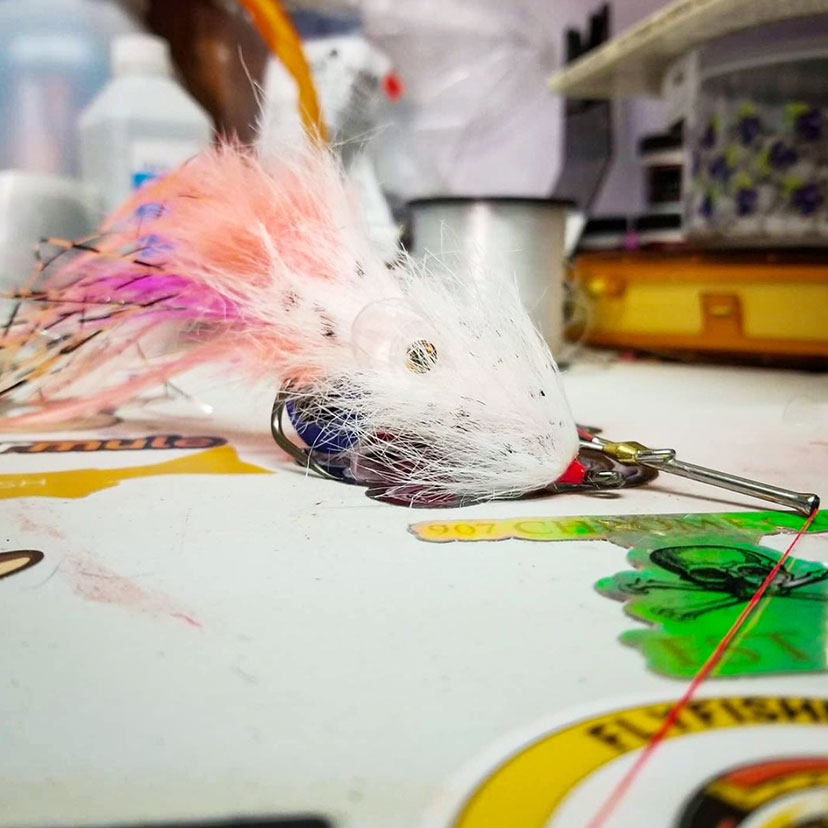
The Octospawn tied in white.
Jason Rivers soon discovered that the fishing scenes in much of the Pacific Northwest—particularly the clades of flyfishing and steelheading—were organized into cliques. You were either in or you weren’t. The upper echelon would be composed of, say, the Spey casters who fished traditional patterns like the Skykomish Sunrise or the Green Butt Skunk, while the lower rungs would be taken up by spin fisherman and/or egg slingers. Rivers found that he didn’t quite fit anywhere within that hierarchy; he’d rather fish the way he wanted to even if that meant transcending certain group boundaries. Such a trait would come to define much of his fishing practice, allowing him to see beyond collective dogma and find new ways to enjoy the sport. That’s what we’re all searching for, right?
Things really took off for Jason Rivers when he and his family moved to Fairbanks in 2007. While this meant leaving the steelhead behind, he was more than compensated by what has to be the best all-around fish for a fly rod: the Arctic grayling. Like many before him, Jason Rivers started to learn the ins and outs of flyfishing courtesy of the “sailfish of the north.” It was also during this period of his life that Rivers met two hugely influential people: Will Smith (no, not Hitch), and Scott Murdock (whom I had the privilege to write about in the April installment of this series).
Rivers described Will Smith as both “a fishy dude” and “one of the best salmon fishermen I’ve ever known.” The two kindred spirits met when they worked as cooks at Sophie Station Suites. Smith has the distinction of originating the Hannah Montana, perhaps one of the most notorious Interior salmon flies. While casting the Hannah on a fly rod should require a baseball helmet, you’d be hard-pressed to find a more effective coho pattern. Rivers did much to gain notoriety for Smith’s pattern (which Smith originally kept on the down-low), and continues to tie various iterations of it. Smith is a large part of why Rivers came to pursue salmon so actively, as well—first on conventional tackle, then on flies. And once the latter happened, Rivers’ tying habits started to get larger and larger…
At around the same time, and undoubtedly a result of his evolving fly interests, Rivers became a self-proclaimed “troll” of Big Ray’s fly shop in downtown Fairbanks. His multiple visits per week, along with his avid perusing of online fly-tying resources, had made him a veritable expert on materials, techniques, and industry trends. He soon landed a job at Big Ray’s where he met Scott Murdock.
One of the first times Jason Rivers showed one of his flies to Scott Murdock, Murdock whipped out a razor blade and reduced the creation to a bare hook within seconds. It wasn’t that it was a bad fly by any means, but Murdock soon showed Rivers how a fly was to be properly tied. The problem that Rivers was facing with his large salmon flies, Murdock was quick to point out, was simply having more space to cover. Proportions were critical; mistakes harder to conceal.
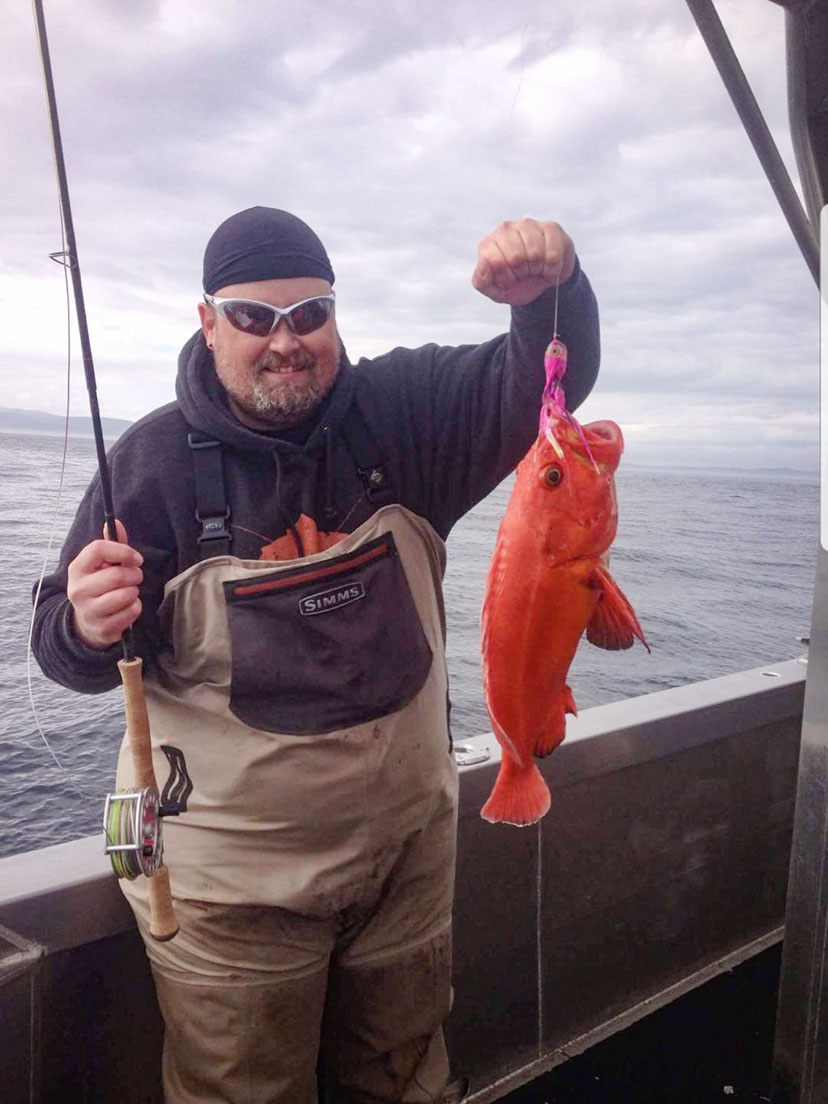
A yelloweye on the fly.
Armed with this new knowledge, and with a fresh zeal for big-game flies, Rivers began to experiment with pike patterns. Minto Flats and the Yukon River drainage, both world-renowned fisheries for large and abundant pike, were right in his backyard, and pike flies presented tantalizing opportunities to hone his craft and create new things. Rivers immediately started tying larger patterns than those he could buy, some to the point that they were more like musky flies. (To be fair, though, some Yukon pike are every bit as large and aggressive as their Midwestern cousins). Rivers also began integrating some Eastern tying techniques into his work; the use of mesh heads found in Atlantic Coast striper flies, as well as the synthetic hair/large profile teachings of Europe’s Niklaus Bauer and Norbert Renaud. The result of these multiple influences was a 12-inch mantle of articulated gold flash, accurately dubbed the Barbie Doll.
Jason Rivers’ other big-game interests soon came to include saltwater species. Either through his own trips to Prince William Sound or living vicariously through the forays of his friends, Rivers developed an abiding interest in halibut. He noticed that many of the halibut he or his friends caught were often full of crabs, but rarely did he see anyone using crab-imitation lures to reflect this forage preference. He spent some devoted time behind the vise as a result.
The problem with fly color for halibut is that these fish are often at depths in excess of a hundred feet. What the human eye might deem a natural color all but disappears down there, so Rivers’ first task became deciding on colors that would be visible, yet also lend themselves to a “crabby” appearance. After nearly a decade in Fairbanks, Rivers and his family moved south to the town of Wrangell, where halibut were right out his front door and there was a year-round presence of the very crustaceans he’d been trying to imitate. Through a combination of homemade synthetic dubbing brushes, rabbit strips, and trailing hooks, Rivers concocted what is sure to become a classic halibut fly: the STD.
After introducing the STD, Rivers was quick to tell me how he names his flies. Many of his ideas are totally random, yet they were inspired in large part by the names he’d seen other tyers get away with in catalogs.
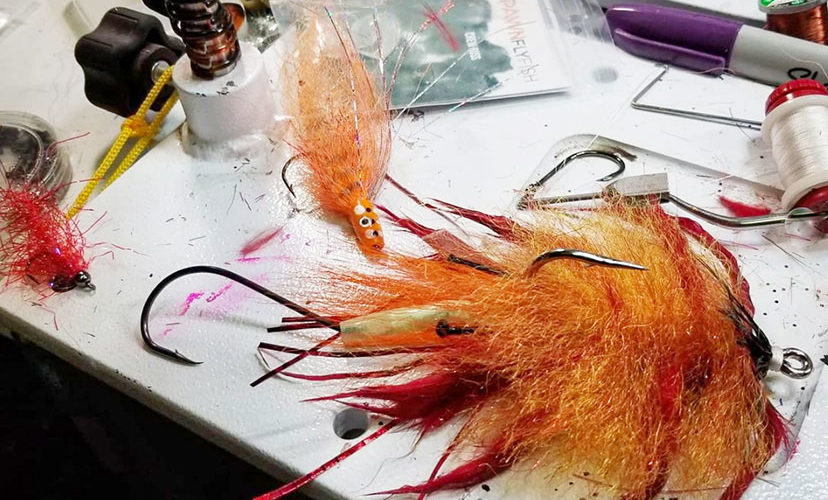
The infamous STD, bound for a barn-door.
“You want to name it something memorable,” he said, and presumably influenced by memories of Washington steelhead cliques and some of their inherent snootiness, he added, “and you can’t get too pretentious about fly names.”
The Sushi Buffet is Jason Rivers’ attempt at naturally mimicking a rotten salmon. Not rotten salmon flesh, mind you, but a whole salmon in the process of rotting. “It’s not all pink and white,” he asserts. “There’s all sorts of gnarly colors in there: black, brown, gray.” He achieves this imitation through a promdress-esque cascade of feathers, each of which can move independently in the water and appear like a salmon falling apart after their biological obligations are complete.
A list (more a rap sheet) of Rivers’ other creations includes a lineup of herring look-alike, king salmon trolling flies; an octopus imitation, dubbed the Octospawn, derived in part from the influence of Norbert Renaud; a squid pattern affectionately called the Christmas Turd that makes use of electrical tubing that Rivers got on eBay; and a derangement of Will Smith’s Hannah Montana that Rivers calls the Trashcan Miley.
The ‘Miley, in particular, demonstrates one of the more bizarre but enviable practices of Jason Rivers. “I never throw anything away,” he told me, referring to discarded fly-tying materials. He keeps a bin handy near his tying desk and sweeps basically anything you can imagine (clipped deer hair, marabou ends, excess flash, etc.) into it. Once he has a full bin, Rivers will run its contents through an old, dilapidated coffee grinder, producing a relatively fine tangle of all colors and shades. Rivers then spins dubbing brushes using this stuff, and the Trashcan Miley is just one creation of many that incorporates the idea.
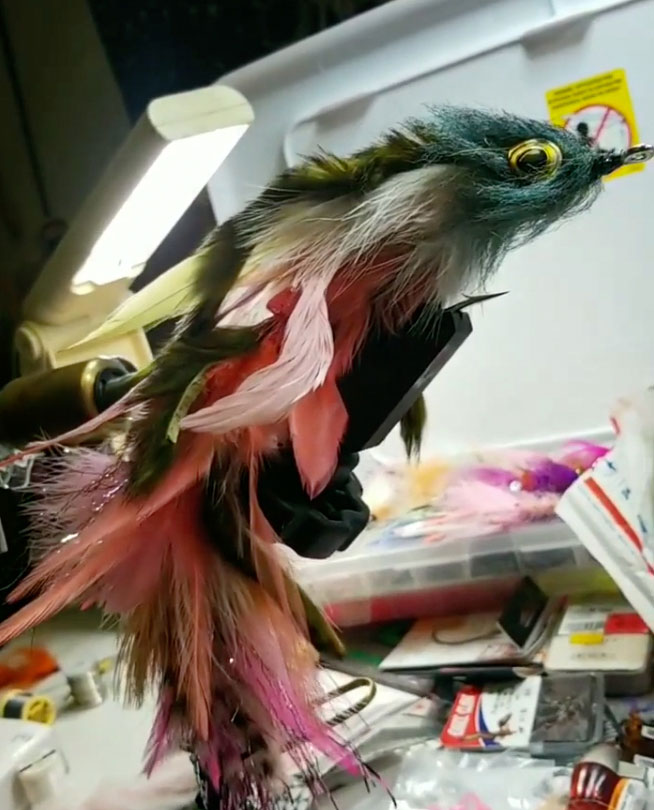
The Sushi Buffet, boasting articulation and an impressive quantity of feathers.
Aside from doling out hours to the fly-tying vise, Jason Rivers manages a small conglomerate of fishing and tackle operations. He paints custom spoons and constructs halibut rigs for Sea Hag Tackle, he designs and produces the next hot saltwater fly at Chicken Butt Flies, and he continues his freshwater pursuits (including establishing a steelhead/salmon guiding outfit around Wrangell) at 907 Chrome Cult. It seems that his days are altogether consumed by fishing, and it would be easy (at least for me, were I in his shoes) to fall into a sort of rut of convention. There are proven techniques and patterns for the species for which he fishes, yet Rivers consistently throws it all out the window and does things his own way. Where others strive to imitate established patterns, Rivers looks to nature itself for inspiration (as evidenced by the STD and Sushi Buffet). Where others might be stopped in their tracks by convention and the pretensions that swirl around our industry—voices that whisper or shout, “You can’t do that!” or “That isn’t a fly!”—Rivers is practically looking around for walls to bust through. As fly tyers, I think we can all stand to be more like that.
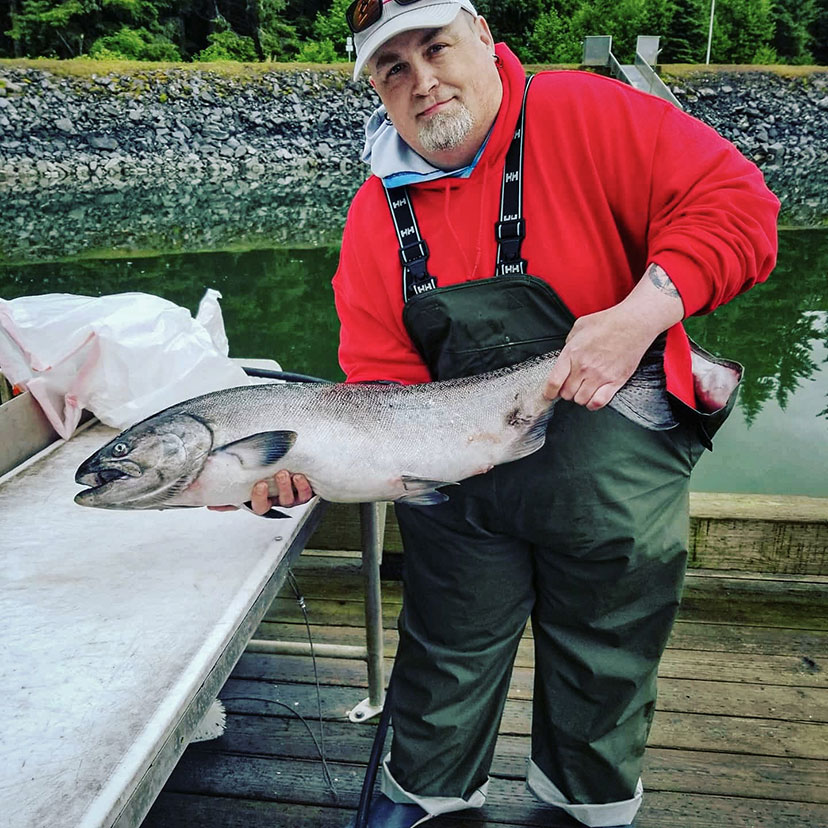
Rivers with a Wrangell king.
These days, one of Rivers’ favorite pastimes (aside from wrapping things in a vise) is fishing the salt near Wrangell for a certain, less-than-desirable species. Thinking back on our two-hour-plus phone conversation, where I’ve heard all about his gigantic halibut flies, his use of a coffee grinder as requisite fly-tying equipment, and his absurd pattern names, I’m not at all surprised.
Naturally, I have to prod him further about this, shall we say, unconventional quarry.
“I get a kick out of it,” he replies, and then chuckles.
I suppose “a kick out of it” is all any of us can ever hope to get from this hopeless pastime. Jason Rivers is going for the world-record Irish Lord on the fly.
Joe Jackson is a fly nerd who wishes to thank each and every subject of “Behind the Vice” for indulging his curiosity. Joe has written for Fish Alaska, The Flyfish Journal, The Drake, and American Flyfishing, and his favorite fly to tie is Fran Betters’ Usual dry fly.
The post Jason Rivers: Tying, Unconventionally appeared first on Fish Alaska Magazine.

